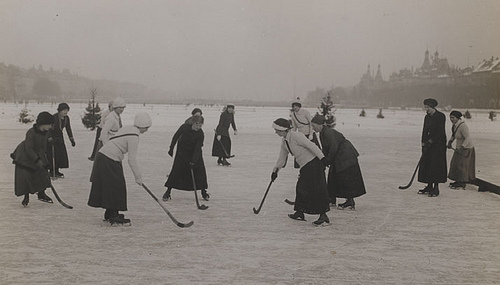BANDY
Bandy - Bandy Ball is played on ice, using a single round ball. Two teams of 11 players each compete to get the ball into the other team's goal using sticks, thereby scoring a goal. The game is designed to be played on a rectangle of ice-field which is the same size as a football (soccer) field. Bandy also has other rules that are similar to soccer: each team has 11 players, one of which is a goalkeeper. A standard bandy match consists of two halves of 45 minutes each. The offside rule is also deployed. A goal cannot be scored from a stroke-in or goal throw, but unlike soccer, a goal cannot be scored directly from a stroke-off or corner stroke. And all free strokes are “direct” and allow a goal to be scored without another player touching the ball. The team that has scored more goals at the end of the game is the winner; if both teams have scored an equal number of goals, then the game is a draw. There are exceptions to this rule, however.

In league competitions games may end in a draw, but in some knockout competitions if a game is tied at the end of regulation time it may go into extra time, which consists of two further 15-minute periods. If the score is still tied after extra time, the game will be replayed. As an alternative, the extra two times 15-minutes may be played as "golden goal" which means that the first team that scores during the extra-time wins the game. If both extra periods are played without a scored goal, a penalty shootout will settle the game. The teams shoot five penalties each and if this doesn't settle the game, the teams shoot one more penalty each until one of them misses and the other scores.
The primary rule is that the players (other than the goalkeepers) may not intentionally touch the ball with their heads, hands or arms during play. Although players usually use their sticks to move the ball around, they may use any part of their bodies other than their heads, hands or arms and may use their skates in a limited manner. Heading the ball will result in a five-minute penalty.

In typical game play, players attempt to propel the ball toward their opponents' goal through individual control of the ball, such as bydribbling, passing the ball to a team-mate, and by taking shots at the goal, which is guarded by the opposing goalkeeper. Opposing players may try to regain control of the ball by intercepting a pass or through tackling the opponent who controls the ball; however, physical contact between opponents is limited. Bandy is generally a free-flowing game, with play stopping only when the ball has left the field of play, or when play is stopped by the referee. After a stoppage, play can recommence with a free stroke, a penalty shot or a corner stroke. If the ball has left the field along the sidelines, the referee must decide which team touched the ball last, and award a restart stroke to the opposing team, just like football's throw-in.
The rules do not specify any player positions other than goalkeeper, but a number of player specialisations have evolved. Broadly, these include three main categories: forwards, whose main task is to score goals; defenders, who specialise in preventing their opponents from scoring; and midfielders, who dispossess the opposition and keep possession of the ball to pass it to the forwards; players in these positions are referred to as outfield players, to discern them from the single goalkeeper. These positions are further differentiated by which side of the field the player spends most time in. For example, there are central defenders, and left and right midfielders. The ten outfield players may be arranged in these positions in any combination (for example, there may be three defenders, five midfielders, and two forwards), and the number of players in each position determines the style of the team's play; more forwards and fewer defenders would create a more aggressive and offensive-minded game, while the reverse would create a slower, more defensive style of play. While players may spend most of the game in a specific position, there are few restrictions on player movement, and players can switch positions at any time. The layout of the players on the pitch is called the team's formation, and defining the team's formation and tactics is usually the prerogative of the team's manager(s).

Bandy Rink / Bandy Pitch / Bandy Field Layout
There are eight rules in the official bandy rules. The same rules are designed to apply to all levels of bandy, although certain modifications for groups such as juniors, seniors or women are permitted. The rules are often framed in broad terms, which allow flexibility in their application depending on the nature of the game.

The rules can be found on the official website of the Federation of International Bandy website or by CLICKING HERE
Each team consists of a maximum of 11 players (excluding substitutes), one of whom must be the goalkeeper. A team of fewer than eight players may not start a game. Goalkeepers are the only players allowed to play the ball with their hands or arms, but they are only allowed to do so within the penalty area in front of their own goal. Though there are a variety of positions in which the outfield (non-goalkeeper) players are strategically placed by a coach, these positions are not defined or required by the rules of the game.
Any number of players may be replaced by substitutes during the course of the game. Substitutions can be performed without notifying the referee and can be performed while the ball is in play. However, if the substitute enters the ice before his teammate has left it, this will result in a five-minute ban. A team can bring at the most four substitutes to the game and one of these is likely to be an extra goalkeeper.
Under the rules, the two basic states of play during a game are ball in play and ball out of play. From the beginning of each playing period with a stroke-off (a set strike from the centre-spot by one team) until the end of the playing period, the ball is in play at all times, except when either the ball leaves the field of play, or play is stopped by the referee. When the ball becomes out of play, play is restarted by one of eight restart methods depending on how it went out of play:
- Stroke-off - Following a goal by the opposing team, or to begin each period of play
- Goal-throw - When the ball has wholly crossed the goal line without a goal having been scored and having last been touched by a member of the attacking team; awarded to the defending team
- Corner Stroke - When the ball has wholly crossed the goal line without a goal having been scored and having last been touched by a member of the defending team; awarded to attacking team. The defending team must locate themselves behind goal line and the attacking team must be situated outside the penalty area with everyone but the executor no closer to the shortline than 5 m. As soon as the corner is shot, the attackers may enter the penalty area and the defenders may rush to try to stop the ball
- Free-stroke - Awarded to fouled team following certain listed offences, or to the opposing team upon a team causing the ball to leave the field over the side-line
- Penalty Shot - Awarded to the fouled team following a foul usually punishable by a free-shot but that has occurred within their opponent's penalty area
- Face-off - Occurs when the referee has stopped play for any other reason (for example, a serious injury to a player, interference by an external party, or a ball becoming defective). This restart is uncommon in adult games
If the time runs out while a team is preparing for a free-stroke or penalty, the strike should still be made but it must go into the goal by one shot to count as a goal. Similarly, a goal made via a corner stroke should be allowed, but it must be executed using only one shot in addition to the strike needed to put the ball in play.
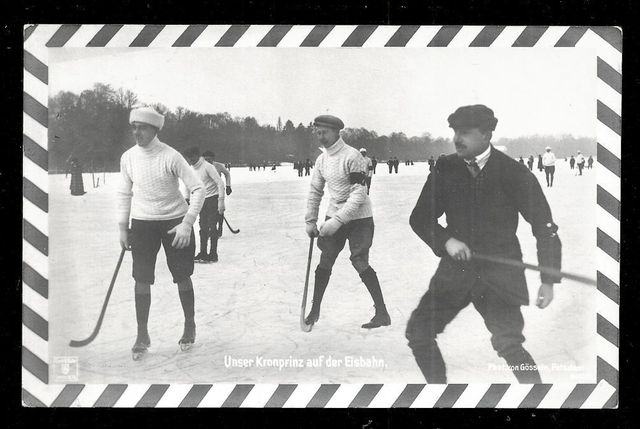
A game is officiated by a referee, the authority to enforce the rules, and whose decisions are final. The referee may be assisted by one or two assistant referees. The referee is the official timekeeper for the match, and may make an allowance for time lost through substitutions, injured players requiring attention, or other stoppages. This added time is commonly referred to as stoppage time or injury time, and must be reported to the match secretary and the two captains. The referee alone signals the end of the match.
HISTORY
Games that are accepted as direct predecessors to bandy have been recorded in Russian monastery records dating back to the 10th to 11th centuries. A game that could be recognized as essentially modern bandy became popular among nobility in early 1700s, with the royal court of Peter the Great playing bandy on Saint Petersburg's frozen Neva river. Russians played bandy with sticks made out of juniper wood, later adopting skates. All the way through modern times, Russia has kept a top position in the bandy area, being one of the founding nations of the International Federation, as well as the most successful team in the World Championships. Russians see themselves as the creators of the sport, which is reflected by the unofficial title for bandy, "Russian hockey," or "русский хоккей."
The first recorded games of bandy on ice took place in The Fens during the great frost of 1813–1814, hardy watermen, gunners and labourers were quickening their circulation by playing Bandy on Bury Fen. Although it is probable that the game had been played there in the previous century.

The 1st particulars of a match come from Mr. Richard Brown, who umpired on the occasion in about 1827. It was a match between Willingham and the Bury Fen players of Bluntisham-cum-Earith, and was fought out on a wash along the Old West River near Willingham. The Game for a leg of Mutton, which all afterwards enjoyed at the expense of the Wellingham team at a neighbouring inn. After play it was usual to have what was called a 'randy' when good healths were drunk, defeat and hard luck forgotten, and fresh matches arranged.
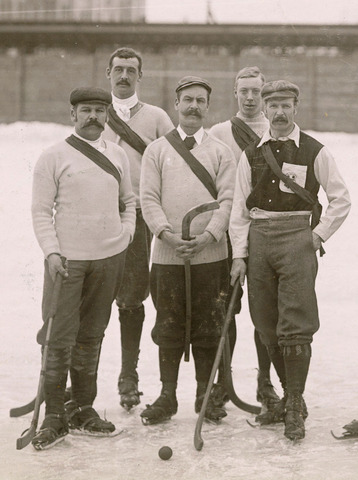
Charles G Tebbutt of the Bury Fen bandy club was responsible for the first published rules of bandy in 1882, and also for introducing the game into the Netherlands and Sweden, as well as elsewhere in England where it became popular with cricket, rowing and Hockey clubs.
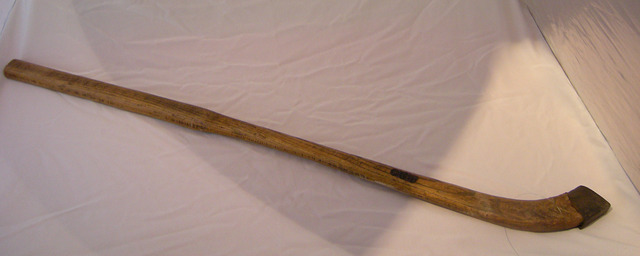
Tebbutt's home-made bandy stick is on display at the St Neots Museum, located in St Neots, within the Huntingdonshire District of Cambridgeshire, England.
Bandy Sticks were often cut from the lower branches of the Pollard Williow trees which abound in the Fens. The lower branches grow in a curve upwards until clear of the upper branches which surround the topped head of the tree, and thus are often naturally just the right shape for bandies. A good Bandy was eagerly looked after ; once possessed it was carefully preserved, and became pride of the owner.
The ball used in Bandy was called a Cat or Kit, often made from a bung of cork, or wood carved balls, cricket balls and balls made from india rubber.
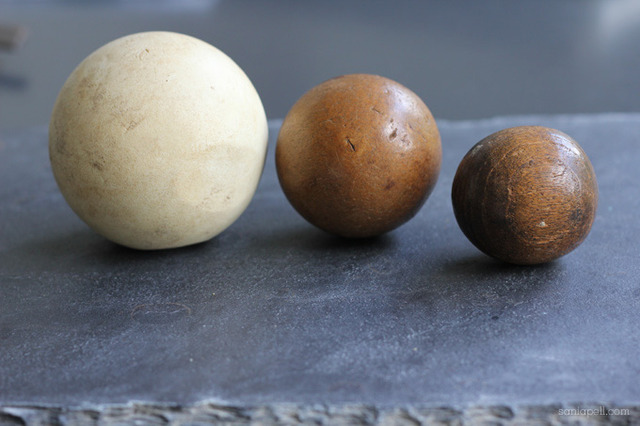
In the western world, Britain has played an important role in the development of bandy. A game similar to bandy was known in Wales as Bando. It was played throughout the country in varying forms and is still to be found in some areas. The earliest example of the Welsh language term bando occurs in a dictionary by John Walters published in 1770–94. It was particularly popular in the Cynffig-Margam district of the Vale of Glamorgan where wide stretches of sandy beaches afforded ample room for play. As a winter sport, British bandy originated in the Fens of East Anglia where large expanses of ice formed on flooded meadows or shallow washes in cold winters, and skating was a tradition.
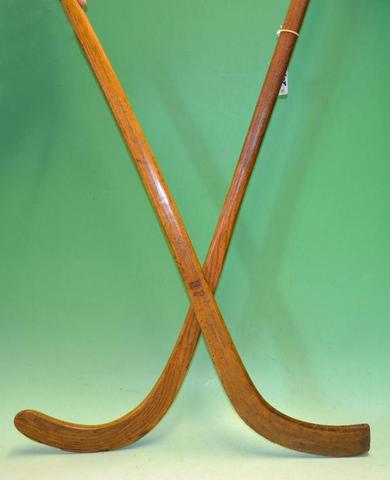
Bandy was introduced to Sweden in 1895. The Swedish royal family, barons and diplomats were the first players. Swedish championships for men have been played annually since 1907. In the 1920s students played the game and it became a largely middle class sport. AfterSlottsbrons IF won the Swedish championship in 1934 it became popular amongst workers in the smaller industrial towns and villages. Bandy remains the main sport in many of these places.
Bandy was introduced to Finland from Russia in the 1890s. The first Finnish national championships were held in 1908. The top national league is called Bandyliiga.
Bandy was introduced to Norway in the 1910s. The Swedes contributed largely, and clubs sprang up around the capital of Oslo. Oslo, including neighbouring towns, is still today the region where bandy enjoys most popularity in Norway.
In 1912 the Norwegians played their first National Championship, which was played annually up to 1940. During WWII, illegal bandy was played in hidden places in forests, on ponds and lakes. In 1943, −44 and −45, illegal championships were held. In 1946 legal play resumed and still goes on.
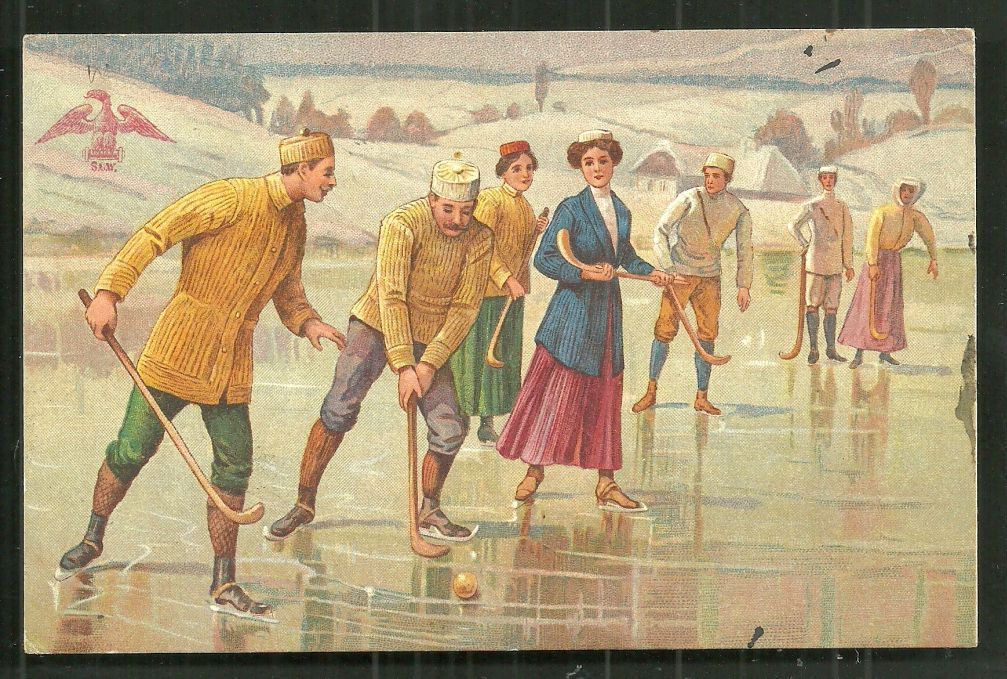
Shakespeare was referring to Bandy in Romeo and Juliet, when he wrote: "The Prince expressly hath forbidden Bandying in the Verona streets" - 1597
Thomas D'Urfey mentions the sport in his 1693 comedy, A Richmond Heiress.
In his 1830 Vocabulary of East Anglia, Robert Forby describes the Bandy as being 'made of very tough wood, or shod with metal, or with point of the horn or the hoof of some animal. The ball or knob or knarl from the trunk of a tree, carefully formed into a globular shape. The adverse parties strive to beat it with their Bandies through one or other of the goals.'
Nottingham Forest Football Club was founded in 1865 by a group of Bandy players, as Nottingham Forest Football and Bandy Club.
The first international Bandy match took place on January 3, 1891 between England's Bury Fen Club and Haarlem in the Netherlands at the Haarlem ice rink, before a large number of spectators, and to the strains of a band.

Women are also very active in the history of Bandy, as seen here in a game being played on the Peblinge Søen in Denmark - 1917
